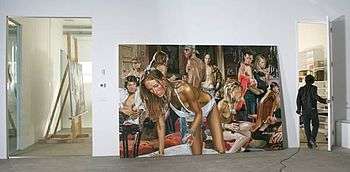Terry Rodgers
| Terry Rodgers | |
|---|---|
| Born |
11 September 1947 Newark, New Jersey |
| Nationality | American |
| Education | Amherst College |
| Known for | Painting |
| Movement | Figurative art |
Terry Rodgers (born September 11, 1947) is an American artist known for his large scale canvases that focus on portraying contemporary body politics. He was born in Newark, New Jersey and raised in Washington, D.C., He graduated cum laude from Amherst College in Massachusetts in 1969, with a major in Fine Arts. His strong interest in film and photography influenced his style in the direction of representational realism in art.
In 2005, three of his monumental figurative canvases were presented at the Valencia Biennial. Abroad he has had solo exhibitions in galleries in Brussels, Amsterdam, Zurich and Milan, and participated in group shows around the world. In the United States, he has had solo gallery exhibitions in New York, Los Angeles, Atlanta, and Chicago.
He has also exhibited at numerous museums in the US including the Museum of Contemporary Art Jacksonville, the Erie Art Museum and the Mobile Museum of Art. Abroad, his work has been exhibited at the Stedelijk Museum - 's-Hertogenbosch, the Kunsthalle der Hypo-Kulturstiftung in Munich, the Museum Franz Gertsch in Burgdorf, the Museum Folkwang in Essen, the Gemeentemuseum Helmond, the Scheringa Museum of Realist Art in Spanbroek, the Kunsthal Rotterdam, the Kunsthalle Emden, the Kunsthalle Krems, the Galerie Rudolfinum and the Zentrum Paul Klee in Bern.

Critical response
Terry Rodgers is a realist known for his contemporary character studies. While his earlier paintings often contemplated personal and family relationships in brightly lit outdoor settings wrought with pale, intense, high-keyed colors, his recent paintings conjure up a vision of the private nightlife of America’s privileged youth. Widely exhibited in the U.S. and Europe and noted for their subtle social commentary. Rodgers’ complex compositions emphasize the detachment of his characters: the eye can trace the angles and curves of their intersecting bodies on the painting’s surface, but their gazes almost all diverge from each other. They seem to share the disappointment of F. Scott Fitzgerald’s hollow glamour seekers and the bourgeois ennui mined by Eric Fischl and David Salle.[1]
Cutting edge art and the figurative is again avant-garde in the paintings by Terry Rodgers. The viewer is at the same time a voyeur and a guest at the party, but an existential calm reigns in the paintings. Rodgers is a master of composition. His strange parties are, despite all their photographic qualities, put together like a painting by Rubens.[2]
There is also a troubled insouciance in his characters despite the appearance of living out a seeming fantasy – the clothes, the looks and lounging in the midst of a quasi-orgy fest – there is something fragile and complex about his characters.[3]
Notes and references
- ↑ Byrd, Cathy. Terry Rodgers at Fay Gold. Art in America. No. 2. February 2006 (review/reproduction).
- ↑ Rump, Gerhard Charles. "Terry Rodgers: Einsam sind die Schonen und Reichen Dieser Welt. " Die Welt (Germany). December 18, 2004 (review/reproduction). (English translation from German.) http://www.welt.de/print-welt/article359209/Terry_Rodgers_Einsam_sind_die_Schoenen_und_Reichen_dieser_Welt.html
- ↑ Cochran, Paul. "The Bold and the Beautiful," Aishti Magazine (Lebanon). December 2006/January 2007 (feature/reproductions).
Further reading
- George Kinghorn, Skin: Contemporary Views of the Body, Museum of Contemporary Art Jacksonville, 2003. ISBN 0-9740580-0-9
- Julia Haussmann, zuruck zur figur, malerei der gegenwart (back to the figure, painting of the present), Prestel Verlag Kunstahalle der Hypo-Kulturstiftung and die Autoren, 2006-2007. ISBN 3-7913-6079-5
- Alina Reyes & Catherine Somzé, —The Apotheosis of Pleasure—Terry Rodgers, TORCH Books, 2006. ISBN 978-90-73920-23-1 | ISBN 90-73920-23-X
- Howard Tullman & Paul William Richelson, Ph.D., Creative Imaginings: The Howard A. and Judith Tullman Collection, The Mobile Museum of Art, 2006. ISBN 1-893174-09-3
- Luigi Settembrini, 3rd Bienal de Valencia: Agua sin ti no soy (Water without you I'm not), 2005. ISBN 84-482-4134-7 | ISBN 88-8158-570-7
- Jim Zimmerman, Vectors of Desire: Terry Rodgers' Vision of the American Millennial Moment, iUniverse/Standing Watch Productions, 2004. ISBN 0-595-32884-9
- Dr. Eva Karcher, "Terry Rodgers—Dimensions of Ambiguity", TORCH Books, 2009. ISBN 978-90-73920-26-2
- Margi Geerlinks, Adriaan van der Have, "The Unforgettable Fire 25 Years Torch Gallery", Art Unlimited, 2009. ISBN 978-90-8699-059-7
- Jeannette Dekeukeleire, Harry Ruhe, "Hidden Delights—Lingerie in the Arts", Art Kitchen Galerie, Galerie A. Johannes Verhulststraat, 2009. ISBN 978-90-812458-2-1
External links
- Official Terry Rodgers Website
- Official Aeroplastics Contemporary Website
- Official Torch Gallery Website
- Camera Littera on The Apotheosis of Pleasure by Camera Littera
- The Absent by Alina Reyes
- Iconique.com Les Arts Digitales feature
- Webesteem Art & Design Magazine feature
- Blend Magazine video documentary of Terry Rodgers
- Die Welt review
- Terry Rodgers on tut-art.ru